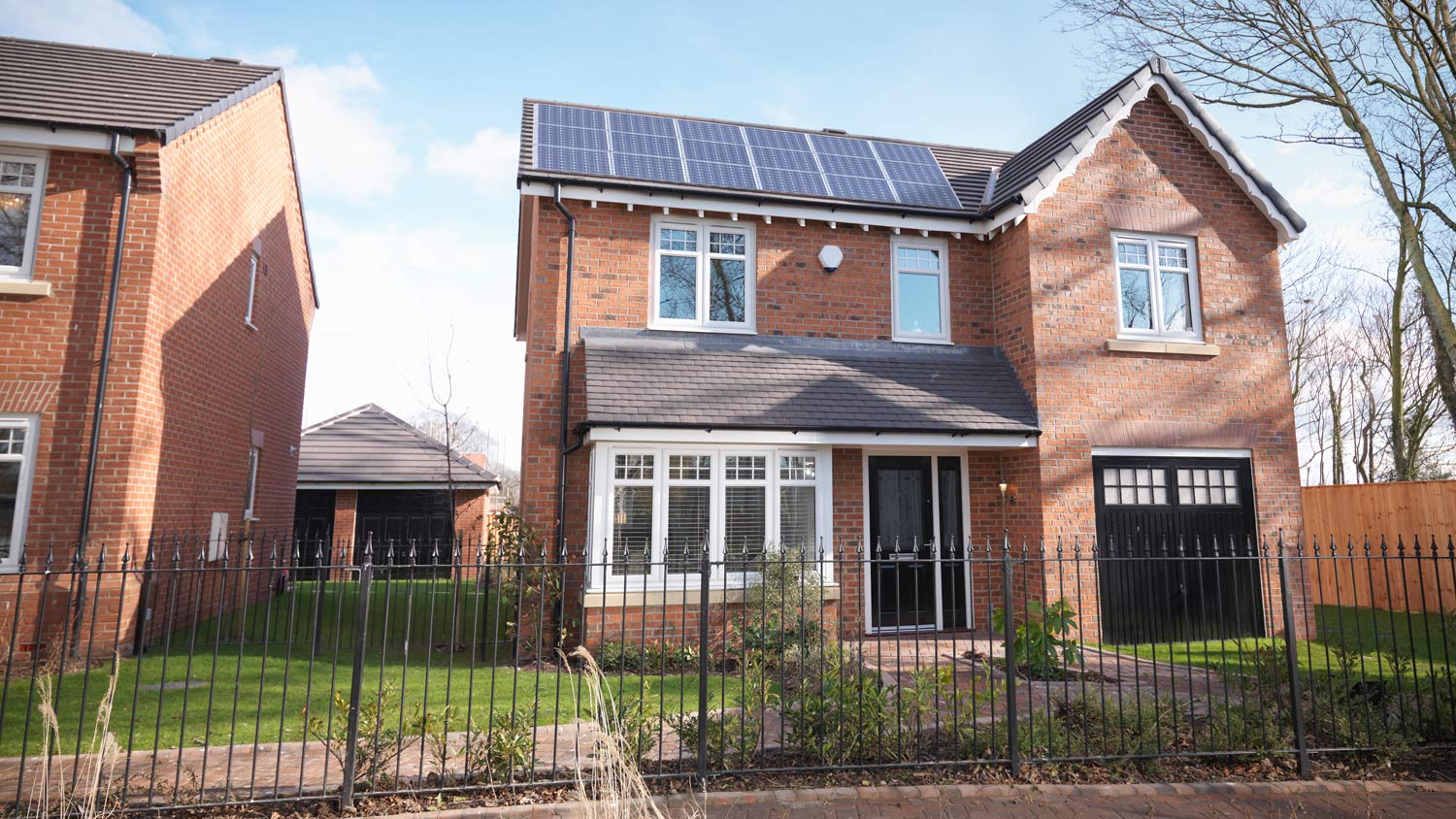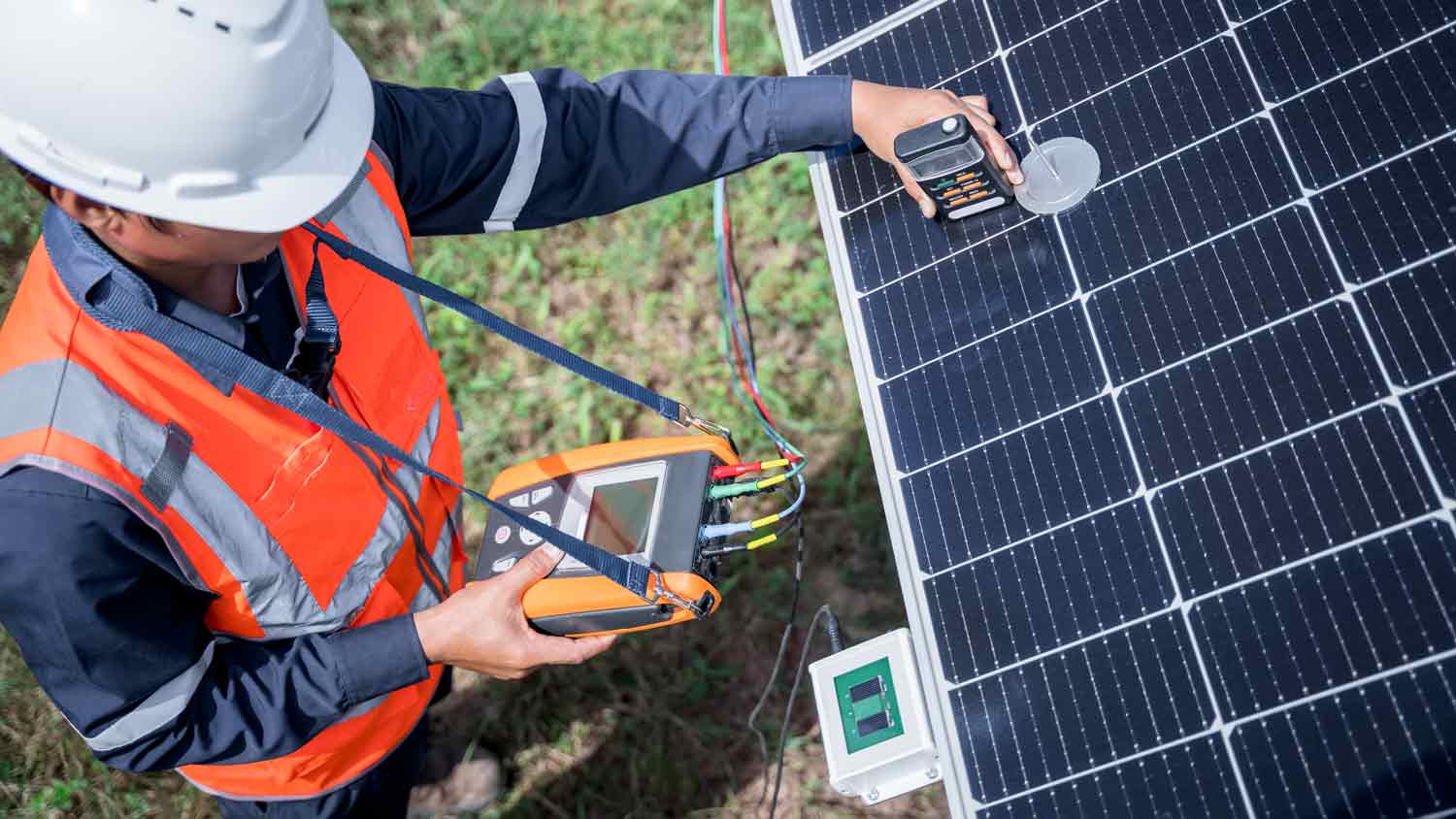
Solar battery costs depend on the size of your system, labor, and capacity. Learn how much you could pay for batteries for home solar systems.
Ensure your panels are more powerful than the storm


Solar panels are hailproof and can withstand hailstones up to 1 inch in diameter that travel up to 50 mph.
Choose UL 61730-rated panels if you live in an area with frequent hailstorms.
Protect your solar panels from severe hail with covers, protective spray, or wire mesh.
Maintain your solar panels to prevent further damage after cracking or denting.
If you already have solar panels or are considering installing them, you may wonder if they’re hailproof. Luckily, solar panels are built to hold up to the most extreme weather conditions, including hailstorms. Learn about how solar panels are hailproof and how to protect your panels during severe storms.
Hail is a type of precipitation that occurs when thunderstorm updrafts carry water droplets into extremely cold air in the lower atmosphere. Those droplets freeze solid, then grow when other droplets collide with them. Eventually, these lumps of ice fall when they become too heavy for the updraft to continue holding them.
So why is hail such a problem? A hailstone can grow to be as large as a golf ball, and if you’ve ever seen a golf ball strike a windshield, you can imagine what could happen during a hailstorm. Of course, some hailstones grow even larger and cause far more significant damage. If your solar panels sustain damage during severe weather, a solar panel repair pro can help you get them in working order.
Solar panels are hailproof, meaning they won’t suffer cracks, dents, or damage when hail strikes them unless the storm is exceptionally severe. Most manufacturers certify that their panels hold up to hail that’s 1 inch in diameter and fall up to 50 mph. Some solar panels can even withstand larger hailstones at faster speeds, so check with your manufacturer.
According to the National Oceanic and Atmospheric Administration's (NOAA) National Severe Storms Laboratory, hailstones can travel up to 100 mph and grow as large as 4 inches in diameter, so protecting your solar panels in severe storms is essential.
Solar panels undergo extensive testing to guarantee their durability and resilience during hailstorms. The National Renewable Energy Laboratory (NREL), the Office of Energy Efficiency and Renewable Energy’s SunShot Initiative, and the International Photovoltaic Quality Assurance Task Force (PVQAT) work together to ensure panels are resilient in almost all weather.
In 2017, a severe hailstorm hit Denver, Colorado, with hailstones up to 2.75 inches in diameter. Significant damage occurred throughout the city, including shattered car windows. Only one of the 3,000 solar panels on the NREL Denver campus broke. The panel broke due to multiple large hailstones hitting the same spot on the panel. This study is a clear sign that solar panels are incredibly hailproof.
Solar panel manufacturers have their products rated against hail as part of their extensive testing. The Underwriters Laboratories (UL) provides hail impact tests and certifications under the UL 61730 rating. The International Electrotechnical Commission (IEC) gives the IEC 61730 rating for international locations.
Solar panels with UL 61730 and IEC 61730 ratings can withstand most hailstorms across the U.S. According to the Underwriters’ Laboratory guidelines, these panels can resist damage from hailstones between 1 and 3 inches in diameter falling between 16.8 and 88.3 mph.

In most hailstorms, your solar panels will experience no damage and still function properly. Severe hailstorms with large hailstones flying at top speeds can cause damage to your panels. It’s best to take precautions to ensure your solar panels stay safe.
Here are the best ways to prevent hail damage to your solar panels during a severe storm.
Most solar panels hold up to most hailstones, but some can handle even larger, faster hailstones. If you live in an area that experiences frequent or severe hailstorms, consider purchasing solar panels with a UL 61730 rating. These materials undergo specific hail testing and are strong enough to withstand 3-inch diameter hailstones striking your panels at up to 88 mph.
You can cover your panels with a hard shell (more durable) or soft cover (still helpful) that protects them from hailstones and other harsh weather. However, you won’t be able to harness and use the sun's energy while the cover is on.
You can spray your solar panels with methacrylate, a transparent plastic material that serves as a protective barrier. The coating doesn't block the sun's rays, so your panels will still harness the sun’s energy—giving this solution a one-up on protective covers. Follow the manufacturer’s instructions when applying methacrylate to ensure you don’t damage the panel or reduce its effectiveness.
You can surround your panels with wire gauge mesh, which lets in sunlight but protects your solar panels from large hailstones. You’ll need to secure the wire properly so it stays on during tough weather.
Look at the weather forecast to see when the hailstorm is coming and in what direction the wind is blowing. Use your automatic angle adjuster to tilt your arrays away from the hail. Once the storm passes, move them back to their standard position.
Check and repair your solar panels periodically for cracks or after a storm. If you notice cracks or dents, big or small, contact a local solar panel company immediately. Small cracks can become bigger if you don’t repair them, especially if a hailstone hits the spot again. Check your homeowners insurance policy or manufacturer’s warranty to see if your solar panels are covered.
While solar panels are hailproof, they don’t always provide power after a storm. If your solar panels connect to a grid and there’s a power outage, the panels won’t work. If needed, you can harness and use energy with battery-powered solar panels even if the grid is down.
Solar panels can still work if they have small cracks, but as they expand, the array won’t work as well, and there’s a risk of a fire if the crack gets too large.
If you suspect damage to your solar panels, contact a local solar panel repair company immediately. They can often repair hail damage with new glass and photovoltaic system parts. You can file a hail damage insurance claim if your solar panels are on your homeowners insurance policy.
From average costs to expert advice, get all the answers you need to get your job done.

Solar battery costs depend on the size of your system, labor, and capacity. Learn how much you could pay for batteries for home solar systems.

Discover the average solar panel inspection cost, what impacts pricing, and how to save. Get expert tips to keep your solar system efficient and safe.

Get a detailed estimate of solar farm costs. Learn about average prices, key cost factors, and ways to save when planning your solar farm project.

If you’re making the switch to solar energy, you’ll want to know the difference between solar panels versus solar shingles. Here are the pros and cons of each.

Are you wondering why your solar panels aren’t working? Here are the reasons why your solar panel system isn’t providing power like it should.

Even the best solar panels don’t last forever. This guide will help you understand how long solar panels last and how to make the most of their lifespan.